Jul 04, 2025
Author:Amanda Lyu
Your cat just snatched a mushroom from your plate. Your heart stops. Is this dangerous? Can cats eat mushrooms safely?
This happens more than you think. Cats love trying new foods. They grab things when you're not looking. On some occasions, they even steal food off your counter.
The relationship between cats and mushrooms is not simple. Some mushrooms won't hurt your cat. Others can kill your pet in hours. Every cat parent needs to know the difference.
Mushrooms appear everywhere—on your pizza, in your yard after rain, and even in plant pots. But knowing which ones are safe is crucial, especially when protecting your cat’s life.
This blog guides you on everything about mushroom safety for cats. You'll learn which types are dangerous. You'll spot warning signs. Most importantly, you'll keep your cat safe.
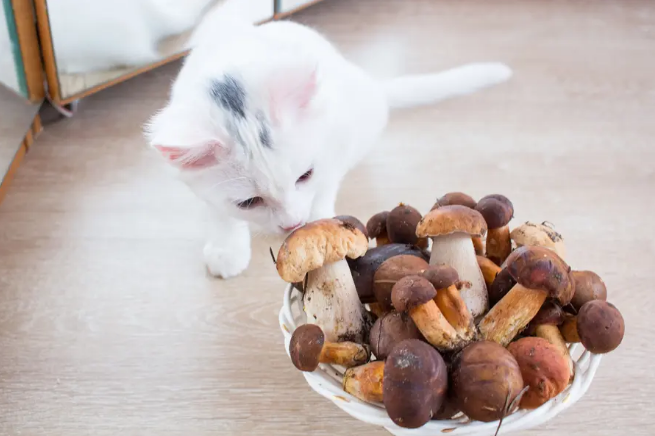
It is essential to realize that there are mushrooms that are not harmful and others that are deadly before allowing your cat to nibble them. So what exactly is the difference between mushrooms in a store and their homicidal counterparts in the wilderness?
Mushrooms that cats can eat safely come from grocery stores. These get checked before hitting shelves. Button mushrooms are safest. These are the small white ones. Portobello mushrooms are okay too. They're just grown-up button mushrooms—some cats like the meaty taste. Shiitake mushrooms are usually safe in tiny bits.
Oyster mushrooms look like fans. They taste mild. Like other store-bought mushrooms, they won't poison your cat in small amounts. But cats don't need mushrooms at all. Cat food has everything your pet needs. Any mushrooms should only be rare treats.
Wild mushrooms and cats spell trouble every time. Even experts can make deadly mistakes. The risks are too high.
● Death Cap Mushrooms
Looks harmless yet very poisonous.
It can destroy the liver.
Frequently found around oak trees.
A single piece is enough to kill an adult cat.
● Destroying Angel Mushrooms
They are as deadly as death caps.
There is no safe amount.
● Fly Agaric Mushrooms
White-spotted, bright yellow.
Induce seizures in cats.
● False Morel Mushrooms
Look crumpled and brain-like.
Strike at the nerves.
It causes severe stomach problems.
Mushroom poisoning in cats shows different symptoms. This depends on the type and amount eaten. Quick action can save lives.
● Vomiting happens first. It might continue for hours. Diarrhea often follows. Sometimes it has blood.
● Not wanting food is a red flag. Cats who normally rush to eat suddenly don't want anything. This happens fast with mushroom poisoning.
● Too much drooling means stomach problems. Your active cat becomes tired. They hide in odd places.
These signs start 30 minutes to 6 hours after eating bad mushrooms. Don't wait.
Breathing problems mean the poisoning got worse. Your cat might pant or struggle to breathe. Yellow eyes or gums mean liver damage has started.
Seizures or shaking show that toxins have reached the brain. If your cat falls or can't stand, every minute counts.
Don't wait for severe signs. Call your vet immediately.
● Remove mushroom pieces from your cat's mouth. Be gentle but quick. Watch for bites. Use a towel if needed.
● Take clear photos of the mushroom. Collect a sample in a paper bag. This helps vets identify what your cat ate.
● Call your vet immediately, even at night. Don't wait for symptoms. Mushroom toxicity in cats moves fast.
● Watch your cat closely. Write down any changes. Note exact times.
Strict rules should be followed whenever you share store-bought mushrooms with your cat. Bear in mind, cats do not require mushrooms as a source of nutrition.
The mushrooms should always be cooked fully. Uncooked ones do not digest easily. Cook plainly - do not use any oils or spices. Cats are sensitive to salt, garlic, onions, and butter. Never use them. Cut mushrooms smaller than your fingernail. Start with tiny amounts - less than 1/8 teaspoon. Watch your cat for 24 hours after the first mushroom treat. Any stomach upset means no more mushrooms.
Give mushrooms once a month at most. They should never be more than 5% of daily food. Stop if your cat shows any problems. Most cats do fine without mushrooms. There are safer treats with better nutrition.
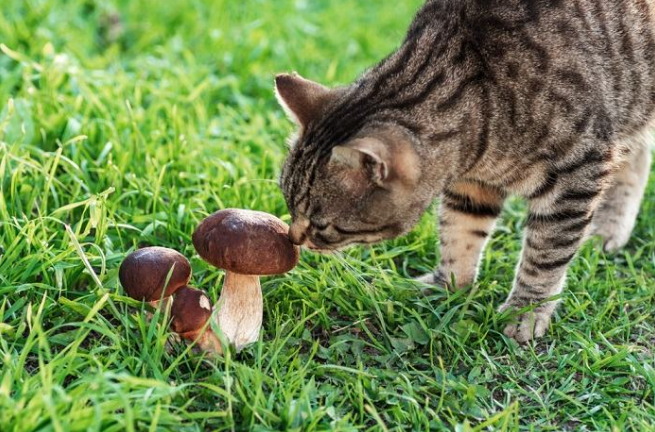
To protect your cat from accidental mushroom poisoning, creating a safe environment inside and outside your home is important.
Store mushrooms in tight containers. Cats climb well and steal food from high places. Clean up scraps right after cooking. You should also teach family members about mushroom dangers. Kids need to know why sharing human food can be dangerous. Check the plant soil for mushroom growth. Some potting soil has mushroom spores. Remove any mushrooms from the plant pots immediately.
Products like WiFi feeders with built-in cameras allow you to remotely monitor your cat’s eating habits. With night vision, you can even catch unusual behavior that could signal they’ve eaten something harmful.
Check your yard weekly for mushrooms. Do this after rain when they appear fast. Remove wild mushrooms completely. Dig up roots to prevent regrowth. Also, drainage should be fixed where mushrooms often grow. Humid, shady places are their favorites. Keeping cats at home during mushroom season may be a good idea.
If you suspect your cat has eaten a mushroom, immediate veterinary care is critical—here’s what treatment and recovery typically involve.
● Making your cat vomit might help if mushrooms were eaten recently. This removes toxins before they are absorbed. Only vets should do this.
● Activated charcoal binds toxins in the stomach. IV fluids flush toxins from your cat's system. They also prevent dehydration.
● Liver support medicines protect this vital organ. Serious ones require a 24-hour observation.
● Follow all medicine schedules exactly. Don't skip doses or stop early. Stick to diet restrictions during recovery.
● Keep your cat calm. Limit activity during healing. Stress makes recovery harder. Attend all follow-up visits.
● Some mushroom toxins cause delayed effects. Professional monitoring catches complications early.
The North American Mycological Association reports frequent identification errors, even among experts. Visual similarities between toxic and safe types create confusion.
Studies show that cats are very sensitive to mushroom toxins due to their small body size. ASPCA Poison Control handles thousands of mushroom emergencies yearly. Quick action improves survival rates.
This research stresses prevention and fast response. Professional vet care is the only reliable treatment for mushroom poisoning in cats.
Instead of risking mushroom consumption in cats, try safe alternatives. Small pieces of plain cooked chicken give the protein cats need.
Commercial cat treats are made for nutrition and safety, and quality brands are tested for safety standards. Freeze-dried meat treats have pure protein with no harmful stuff.
Cat grass satisfies your cat's urge to nibble plants. It's safer than wild plants or mushrooms. It helps digestion, too.
Cats and mushroom safety depend on prevention. Study the poisonous mushrooms you are likely to come across in your locality.
Regular yard maintenance includes checking for mushrooms. Don't forget areas under decks or near trees where they grow.
Secure human food with mushrooms. Clean thoroughly after cooking mushroom dishes. Keep emergency numbers handy - your vet and Pet Poison Helpline.
WOpet has been transforming the pet care industry into a reliable brand recognized by pet parents in many parts of the world. They focus on developing intelligent feeding systems that facilitate pet ownership and make it safer.
The brand concentrates on integrating new technology and the realistic needs of pet care. The mission of WOpet is to enable pet owners to offer regular, healthy food to their cuddly family members.
WOpet comprehends that good nutrition eliminates the need for the cat to search for unsafe foods such as mushrooms.
● WOpet Patrol Automatic Feeder
● WOpet Automatic Pet Feeder WiFi Cat Feeder Remote Control
● WOpet 7L WiFi Automatic Cat Feeder With Camera Dog Food Dispenser
Even licking introduces toxins. Contact your vet immediately rather than waiting for symptoms.
Store-bought mushrooms are safer than wild ones, but give sparingly. Cook them plain and offer tiny amounts as rare treats.
The symptoms begin 30 minutes to 12 hours after food consumption. Some effects don't show for days. Call your vet early.
Yes, through plant soil, potting mix, or human food. Check indoor plants for mushroom growth regularly.
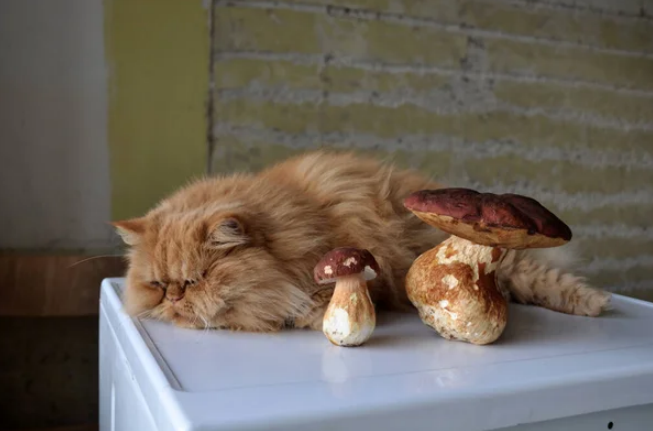
Cats can eat mushrooms, but only with caution. Commercially available varieties are safe in low doses, but the dangers must be balanced against possible advantages.
However, wild mushrooms are never safe for cats. Change of identity and risk of deadly toxin is a great threat to them, and just not worth it.
Cat food already has all the nutrients your pet needs, so mushrooms don’t add any benefit. Using smart feeders can help you keep your cat’s diet on track without taking any risks.
Visit WOpet today for pet care solutions and feeding technology designed for your pet's safety. Your cat depends on your protection from dangers like toxic mushrooms.
Label:
Popular Post

What to Feed a Sick Dog With No Appetite? [2025 Guide]
May 16, 2023
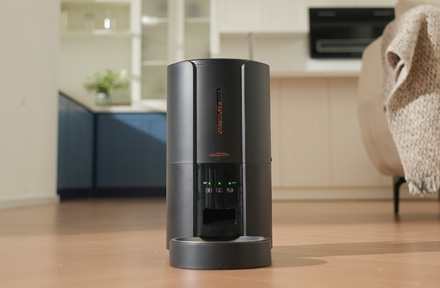
Troubleshooting Common Issues with Automatic Pet Feeders: Tips & Tricks for Pet Owners
Oct 26, 2023
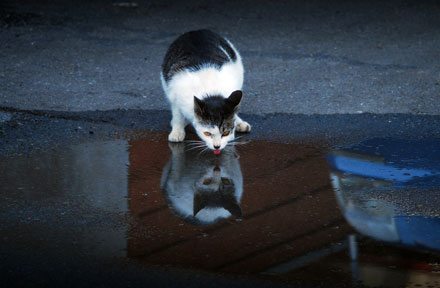
Why Does My Cat Cough After Drinking Water? 8 Potential Reasons
Mar 13, 2023
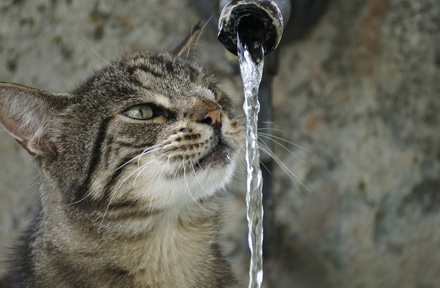
Why is My Cat Throwing up Water? Top 5 Causes Here
Feb 08, 2023
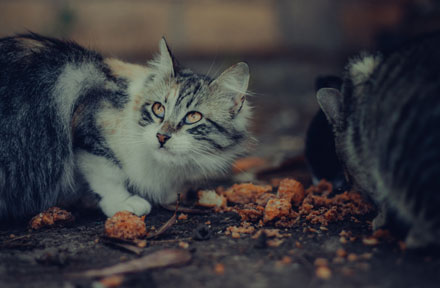
My Cat Only Eats A Little at A Time - What to Do?
Feb 27, 2023
$99.99
$129.99
Copyright © 2025 WOPET. All Rights Reserved.